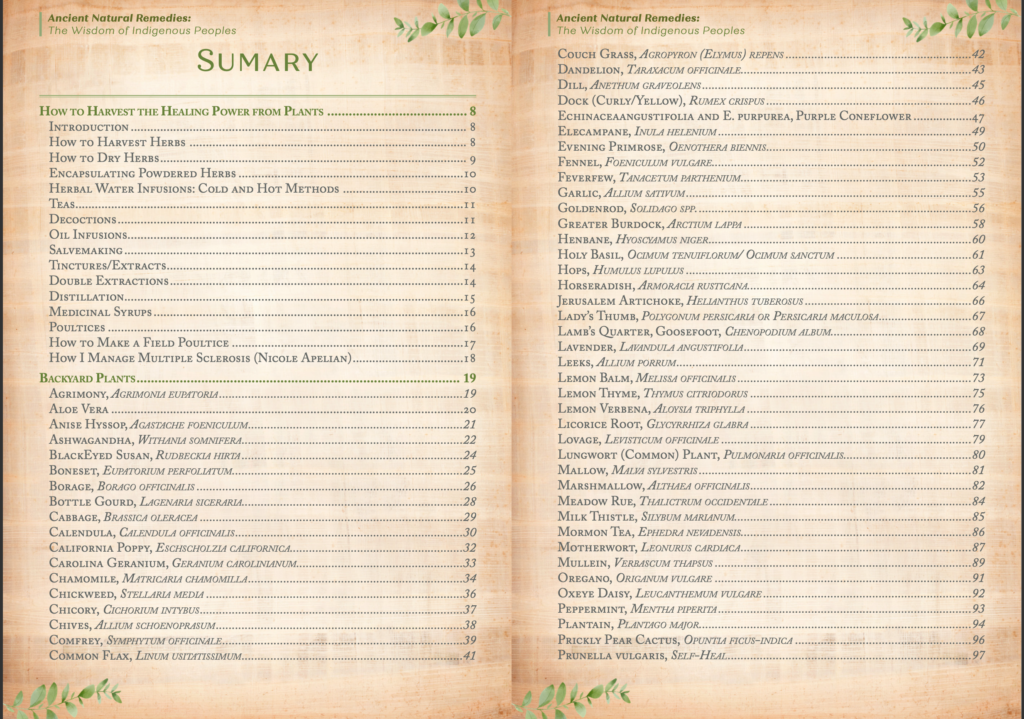Here are some things you will discover inside this massive 284-page guide on herbal remedies:
Here's just a glimpse of what you'll find in the forbidden book of medicinal herbs:
There are two distinct ways to search in the book.
First, you can easily navigate the book by looking for a specific plant or finding out which plants are growing in your area.
Each plant features between 2 to 4 high-quality color photos and detailed identification instructions, so that anyone can use it as a field guide in the yard or whenever going out foraging.
On page 121
Pain-relieving plant that grows in most yards

This is one of the plants you will find in Ancient Natural Remedies. If it looks familiar, it’s because it grows in home yards, and many people tend to pull it out. But what they probably don’t know is that this plant contains a milky substance called lactucarium, which acts directly on the central nervous system (CNS) to reduce the sensation of pain.
Inside the book, you will find complete instructions on how to turn it into an extract that you can use whenever you need it.
On page 29
What happens when you put salt on a cabbage?

On page 29, we will discover something interesting that happens when you put salt on a cabbage.
The end product of the fermentation – called sauerkraut – is full of probiotics that protect your digestive tract, regulating bowel movements and, in many cases, preventing both diarrhea and stress.
on page 188
Quick remedy for sore throat

Money may not grow on trees, but many of the things people pay money for do.
This one, which you’ll find on page 188, was widely used by indigenous people whenever they had a sore throat.
The leaf that people should put in their shoes

You will also discover a plant that increases your energy and relieves foot pain when you use it inside your shoes.
__

on page 25
Break the fever with this recipe
Another plant you will find in Ancient Natural Remedies is the Boneset herb, which indigenous people used to reduce fever.
In fact, the name Boneset originated from the plant’s use in fever-breaking treatments.
You can find a recipe on page 25 of the book.
on page 238
What happens if you dry Willow leaves?

You obtain a natural remedy very similar to aspirin but without causing gastric damage. You can use the dried leaves to make a tea that helps alleviate pain and fever. You can also chew on the tip of a willow branch to achieve the same effect.
If you didn’t know, white willow contains salicylic acid, a substance very similar to aspirin (acetylsalicylic acid) with similar properties.
__

on page 252
Natural Doxycycline - The Antibiotic That Probably Grows in Your Garden
If you’re like most modern people these days, you probably have no idea about the powerful natural remedies that could be hidden in your own garden. Usnea is one of those remedies. It grows in long filament-like strands, earning the nickname ‘Old Man’s Beard.’ It’s the only lichen with a white core, so if you find that, you know you’ve found the right lichen.
The difference between laboratory-produced antibiotics like Doxycycline and Usnea is that Usnea doesn’t harm the gut flora nor potentially make other antibiotics less effective over time.
So, why not consider its use as a natural antibiotic for use in communities, reserving prescribed antibiotics only when we really… really need them?
on page 30
Better than sleeping pills

You will also find a very special plant that can reduce stress levels and, in doing so, helps people have a good night’s sleep.
Deep sleep is the only time your body has to clear away dead cells or repair them. That’s why people who sleep well tend to live longer.
That was just a glimpse of what you will find in Ancient Natural Remedies.
Don't miss the opportunity to transform your health and well-being with our amazing product! By clicking the buy button right now, you'll be taking the first step to enjoy all the benefits this product has to offer. Moreover, you'll be investing in yourself and your future. Don't hesitate, click the buy button now and discover how this product can change your life for the better!
Here are some things you will discover inside this massive 276-page guide on herbal remedies:
- Put this spice in your shoes to combat nail fungus.
- Wildflowers that boost happiness hormones.
- What happens if you mix lemon with bay leaves?
- The Plant-Based Body Map: which plant do you need to heal each organ?
- What happens if you smoke Verbascum leaves?
- The "Anti-Anxiety" Elixir
- The Killer Tree you should never have in your garden.
- Homemade Juice for Blood Pressure
- Natural Homemade Hair Growth Spray for Bedtime.
- A Herbal Homemade Fat-Burning Tea.
- And much more!

Who has already bought the book?
Política de Privacidad | Términos y Condiciones
Para soporte del producto, póngase en contacto con el proveedor por correo electrónico support@nookofnature.com. Este sitio NO es parte del sitio de Facebook ni de Facebook Inc. Además, este sitio NO está respaldado por Facebook de ninguna manera.


















